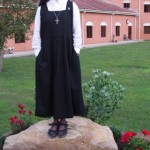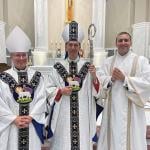There is a story–or a bit of blarney, I’m not sure which–about why Catholic priests wear the distinctive Roman Collar, all black with just a tab of white showing at the front, rather than the full white collar. I heard it a while ago, and don’t remember details, but in this telling it seems that during wartime many priests were easy targets because their all-white collars were easy to see, particularly at night, and so the collar was changed to what we see today, and the rectangle of white amid the black has become a symbol of light, piercing the darkness.
It all sounds very Irish to me, but it may be true, so I am putting a few feelers out amongst my friends to get the whole skinny on the collar.
In the meantime, I hope you will go read what this young seminarian has to say about wearing the collar while he is in formation:
The time of seminary formation is time spent trying to develop the heart of the Good Shepherd. Wearing the collar helped me do that. It helped me tell the people of St. Josephs that I was theirs, that I existed to serve them. Wearing the collar I represented someone much greater than myself. It is not I who serve, but Christ, whose yoke I wear.
The collar pointed to this reality.
This piece is part of the Habit of Witness Series, and I confess that until I read it, I had never thought of the Roman Collar as being the “yoke of Christ.” But it’s a lovely thought and one that is completely in keeping with what Sr. Mary Catharine of Jesus writes about here, in describing the meaning of the monastic habit, of which the scapular is the “yoke.” One could extrapolate that a bit to easily consider that the Roman Collar is, in a manner of speaking, a priest’s “habit” – the outward sign of his consecration.
I like this piece by “Seminarian Michael” and hope you will too. I actually stumbled into a mass where he was making his farewell to the parish he writes about, and it was clear that he had formed a true and heart-felt bond with the community. He was full of gratitude for their support and all they had taught him, and I thought, “if he keeps going like that, full of fervor, tempered by humility, he’s gonna be a great priest!”
At one point during a coffee break at last September’s Church Up Close seminar the subject of vocations came up, and someone noted the slow-but-steady (and world-wide) increase in seminarians since the “long Lent” of 2002 and the first disclosures of our too-poorly-addressed, too-poorly-handled scandals. One priest said–with a profound and almost palpable sense of humility–“it is miraculous! No one can say these young men are coming in unaware of the negatives they face, and the distrust, or that they will be burdened and tarnished by this. They are aware! And yet they hear the call and they come. It is a true mystery, and a mark of grace.”
Yes, the generation of priests being formed amid all of this scandal and controversy–and the ever-powerful lure of the secular life, and the ebbing away of those poorly formed in the faith–means that they are being challenged and humbled right from the start of their journeys. But perhaps this crucible they’re in will make them strong enough and resilient enough to bring reinforcements to what has been weakened. I pray for them–for seminarians and priests, and all people consecrated to God–every day.
We Christians like to talk about being a “sign of contradiction” to a self-interested, distracted and agnostic age, but as we try to live our lives in faith, we do get to walk into a Target and buy a pair of jeans without having anyone challenge us on it. It’s quite a different thing, I think, to outwardly identify yourself as being part–some would say a radical part–of that contradiction. Those who do walk into a Target and risk becoming a target, as well; they could use a few extra whispered up prayers on their behalf.
Another Seminarian Story: this one concerning a young man whose life may have been saved through the intercessory prayers of Cardinal Francis Xavier Nguyen Van Thuan
“During my coma, there are only two things I remember,” he said. “The only two things I remember are two visions of Cardinal Van Thuan … He appeared to me twice.”
Joseph said he not only saw, but actually met and spoke with Cardinal Van Thuan, during two vivid incidents he described as a “separation of soul and body.” Although he said he couldn’t reveal the details of the ecounters, he did say that he suspected that they occurred while his doctors were observing his loss of brain activity and decline in vital signs.
“Soon after the second visit” with the cardinal, he said, “I woke up from the coma.” He had “no idea what had happened,” or why he had “all these tubes and wires” coming out of his body, particularly the tube in his neck that kept him from speaking.
Doctors thought it would be months or years before he could speak, walk, or study. But within days he was talking and breathing normally, racing his nurses around the rehabilitation room. He also received an entirely unexpected phone call from Cardinal Van Thuan’s sister in Canada, who ended up giving him one of her brother’s rosaries.
Joseph returned to the seminary at the beginning of the following semester– a far cry from the two years his doctors had advised him to wait.
Related:
Deacon Greg’s Homily: about Cardinal Van Thuan’s long imprisonment and his unwavering faith
Deacon Greg, Again: on Why a priest should wear the collar.
And: Something Beautiful
O/T but also beautiful











